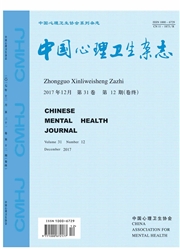

 中文摘要:
中文摘要:
目的:考察不同情绪环境中的视觉搜索任务对抑郁症患者负性注意偏向的影响。方法:选取27例符合美国精神障碍诊断与统计手册第4版(DSM-IV)抑郁症诊断标准的抑郁症住院患者,以及27例性别、年龄、受教育程度与之匹配的正常对照。选用Nimstim情绪面孔图片库中的高兴、悲伤和中性面孔作为刺激材料,使用视觉搜索范式,比较两组被试在不同情绪环境中搜索反应时的差异。结果:抑郁组在高兴、悲伤环境中的反应时显著大于正常对照组[(4717.7±1907.1)ms vs.(2406.2±1210.4)ms;(5186.1±2078.8)ms vs.(3093.0±1244.2)ms;均P〈0.001];抑郁组在高兴与悲伤面孔环境中的反应时的差异无统计学意义(P〉0.05),而正常对照组在高兴面孔环境中的反应时小于悲伤面孔环境中的反应时[(2406.2±1210.4)ms vs.(3093.0±1244.2)ms,P〈0.05]。患者组HAMD得分与反应时的相关无统计学意义(P〉0.05)。结论:在面孔视觉搜索任务中,与正常被试相比,抑郁症患者抗情绪刺激干扰能力更差,没有表现出负性注意偏向。
 英文摘要:
英文摘要:
Objective: To investigate the effect of the visual search task in different emotional conditions on the negative attentional bias in patients w ith depression. Methods: Tw enty-seven patients w ith depression meeting the criteria of Diagnostic and Statistical M anual of M ental Disorders,Fourth Edition( DSM-IV) and 27 gender-,age-and education level-matched normal subjects involved in this study. All participants completed the visual search task w hich used the happy,sad and neutral faces as stimuli to examine the difference of the response time in different emotional conditions by calculating the reaction time. Results: The reaction time of the patients w as significant longer than the normal subjects in the happy and sad faces [( 4717. 7 ± 1907. 1) ms vs.( 2406. 2 ± 1210. 4) ms;( 5186. 1 ± 2078. 8) ms vs.( 3093. 0 ± 1244. 2) ms; Ps 〈0. 001]. The differences of reaction time of patients betw een happy and sad faces w ere no statistical significance( P 〉0. 05),and to the healthy control,the reaction time in happy faces w as significantly less than that in sad faces [( 2406. 2 ± 1210. 4) ms vs.( 3093. 0 ± 1244. 2) ms,P〈 0. 05]. There w as no correlation betw een reaction time and HAM D scores in patients( P 〉0. 05). Conclusion:Comparing to the control,the depression may be more susceptible to emotional information in visual search tasks,don' t show a negative attentional bias.
 同期刊论文项目
同期刊论文项目
 同项目期刊论文
同项目期刊论文
 期刊信息
期刊信息
